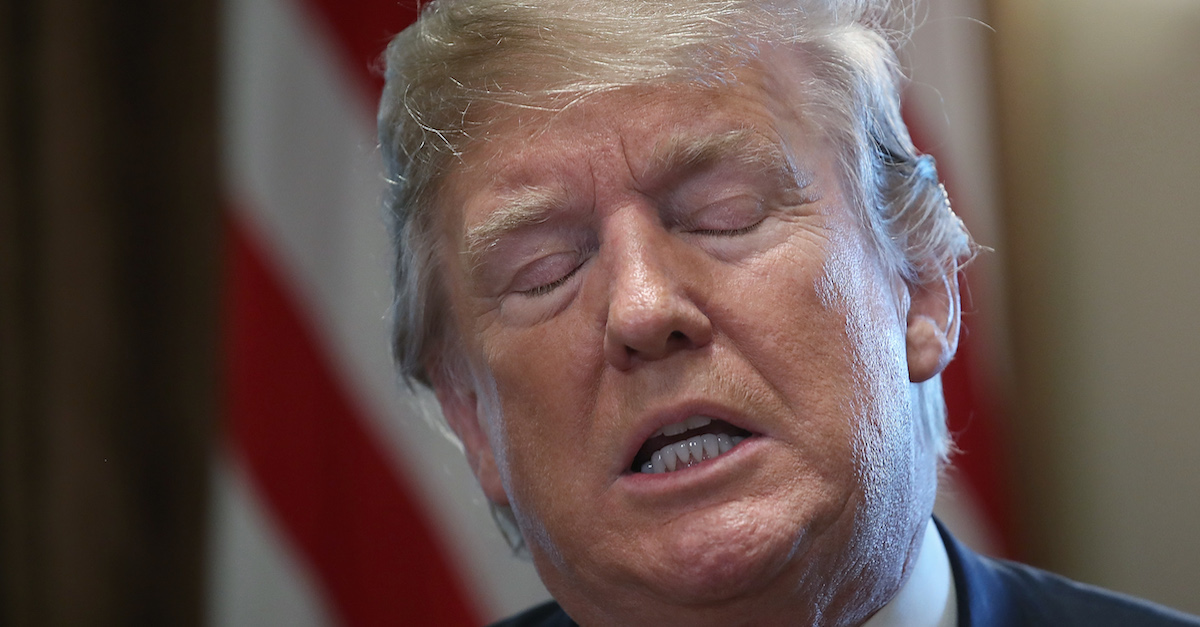
President Donald Trump is flipping out over Thursday’s Supreme Court ruling on the inclusion of a citizenship question in the 2020 census. While the court didn’t say including the question was impermissible, it did say that there was a “significant mismatch between the decision” that Commerce Secretary Wilbur Ross made and “the rationale he provided.” Thus, the court agreed with the lower court’s blocking of the question and sent this back to Commerce.
Trump reacted on Twitter, saying that he’s “asked the lawyers if they can delay the Census, no matter how long” until SCOTUS gets “additional information” needed to ensure his Adminstration’s victory.
Here’s why Trump had a Twitter meltdown about this.
1. He’s probably not going to get to insert that citizenship question after all.
The Supreme Court blocked the addition of a citizenship question to the 2020 census on Thursday, ruling that the Trump Administration failed to provide a genuine explanation for including the question. The Court’s decision on the census question may be something of a mess of partial concurrences and dissents, but they add up to a loss for Trump. The citizenship question remains blocked for now, and there may not be enough time for it to become un-blocked so that the Administration’s desired version of the census can be rolled out.
As Vox noted:
The Commerce Department has acknowledged that in an emergency, with “extraordinary effort,” it could finalize the census forms as late as October 30 and still run the census in time in 2020. So in theory, it could spend some time gathering new evidence, issue a new decision adding the question to the census, and then get the courts to review that decision and uphold it as correct.
But it would have to do all that within four months, tops. The existing case took a year to adjudicate at trial, and another five months from the initial ruling to Thursday’s SCOTUS decision.
In other words, the strategy on timing totally backfired.
In an effort to get SCOTUS to rule quickly on the census issue, the Trump Administration told the courts that printing of census forms must begin on June 30. That’s three days from the Court’s ruling. So the government has a choice: print those census forms without the citizenship question, or delay and brace for the consequences.
Trump himself said that he wants to delay as long as necessary, even as an upcoming election looms large in the background.
2. His Administration got called out for lying.
Secretary of Commerce Ross (who decided to include the citizenship question in the census) argued the need for the question by saying he was trying to better enforce the Voting Rights Act (VRA). Ross’ real motivation appears to be derailing the counting of Hispanics and immigrants, thus providing those communities less-than-fair amounts of government representation.
Reviewing the District Court’s decision, SCOTUS lined up Ross’ story with the evidence adduced in court. And that didn’t go so well for the Trump Administration. The citizenship question had been planned for quite a while:
That evidence showed that the Secretary was determined to reinstate a citizenship question from the time he entered office;
Then later, Ross explained his decision by citing enforcement of the VRA. SCOTUS wasn’t buying it.
We share the District Court’s conviction that the decision to reinstate a citizenship question cannot be adequately explained in terms of DOJ’s request for improved citizenship data to better enforce the VRA.
And down came the hammer:
Altogether, the evidence tells a story that does not match the explanation the Secretary gave for his decision.
Ouch. “Telling a story that does not match” an explanation given by a party to a case is polite judge-speak for “lying.”
3. The Administration could’ve won, but they totally bungled this. It could also get worse.
SCOTUS was tasked with answering whether inclusion of the census question violates the Constitution in various ways; it ruled that the question could be permissible. The problem wasn’t that it was illegal per se, but that the Administration was bullshitting about why they wanted the question included.
#SCOTUS literally held in the ruling @realDonaldTrump is criticizing that, in general, it _is_ permissible to ask about citizenship on the Census.
The problem here was the verkakte (and “contrived”) manner in which the government attempted to manufacture a reason for doing so. https://t.co/XpcU9wsttU
— Steve Vladeck (@steve_vladeck) June 27, 2019
While Trump is raging over how it’s outrageous that citizenship can’t be asked about in America, he totally missed the part where it can be asked, but where his people forgot to show a non-discriminatory purpose in their thought process. What’s more, what’s been dismissed as a conspiracy theory by the DOJ may end up proving the real motivation for the census question’s inclusion. After new documents from the estate of recently deceased Republican operative Thomas Hofeller went public, it was alleged that these records showed that Hofeller specifically orchestrated the addition of the citizenship census question to achieve certain advantages. Hofeller notoriously specialized in gerrymandering maps to ensure Republican advantages.
Challengers of the census question filed documents on June 14 in U.S. District Judge George J. Hazel‘s court in Maryland, writing “These newly discovered documents…eliminate any colorable doubt about the link between Hofeller and government employees involved in the citizenship question approval process.” Judge Hazel agreed on Monday that the Hofeller evidence “potentially connects the dots between a discriminatory purpose–diluting Hispanics’ political power–and Secretary Ross’s decision.”
[Image via Win McNamee/Getty Images]
This is an opinion piece. The views expressed in this article are those of just the author.